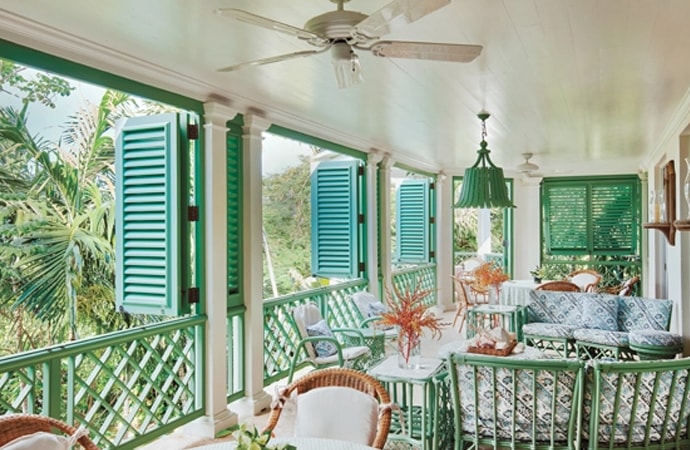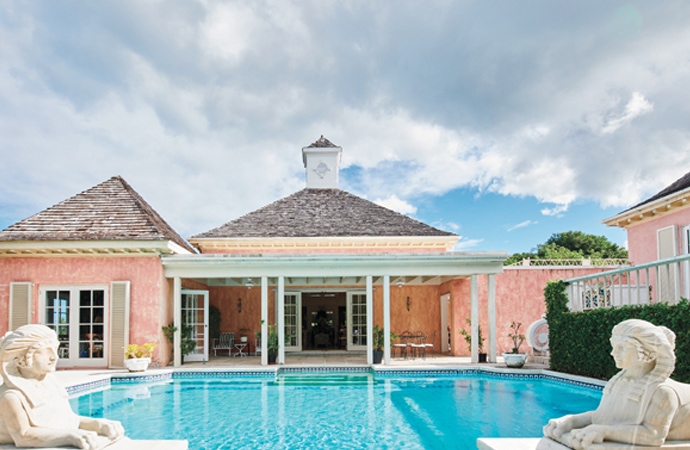The Residential Masterpieces of Caribbean Architect Henry Melich
'Island Follies: Romantic Homes of the Bahamas' focuses on Melich’s most fanciful works and more colorful clients
September 28, 2022

Reflecting pool at Pavilion, 1974 / Photo: Robin Hill
To enter the world of architect Henry Melich is to go back to an era when glamour was, well, glamorous, and dreams came true. The time was the mid-to-late 20th century, and the location was the Bahamas. There the Czech-born, British-educated Melich created worlds within worlds—sprightly tropical caprices, animated fantasies and escapist fiction—but of stone and wood and stucco, often set in exotic gardens.

Furnished veranda at Hope Hill / Photo: Michael Mundy
A new book, Island Follies: Romantic Homes of the Bahamas (Rizzoli), not only tells Melich’s story but also offers a social history, spanning the transition from British colonialism to Bahamian independence. Author Alastair Gordon interweaves architectural and anecdotal threads to bring to life an alluring yet ephemeral era that exists today largely in photographs, film, novels and memories. Melich arrived in 1954 at the age of 30 when the Bahamas—“a once sleepy outpost of the British Empire, almost forgotten before World War II,” as Gordon puts it—were being rediscovered. The islands were, it seemed, a place unlike any other, dreamy, tropical and isolated.

Reflecting pool at Pavilion, 1974/ Photo: Michael Mundy
Melich had been classically trained in England, and had worked on both Westminster Abbey and St. Paul’s Cathedral as a young architect in London. “The basis of all his work,” says his daughter, Tanya Melich Crone, “was rooted in historical training.” That education was brought to bear on an array of buildings in the Bahamas, ranging from houses for the rich to charitable projects, all designed with passion and rigor. As almost a public signature, Melich designed the harbor side of Rawson Square, the first building shipborne travelers would see when they docked in Nassau.
Island Follies focuses primarily on Melich’s most fanciful works and more colorful clients. Gordon points out that the architect “offered them a menu of architectural delights,” drawing on his deep knowledge of history and fertile imagination. His work brought him into contact with royalty, wealth and celebrity, ranging from Sean Connery and Christopher Plummer to the entertainment mogul Chris Blackwell and Lynden Oscar Pindling, the first Black prime minister of the Bahamas.
His clients often had dreamy ideas for their Bahamian estates. Sibilla O’Donnell, the daughter of the Duke and Duchess Della Torre of Italy who wed the already twice-married and well-pedigreed Columbus O’Donnell and best known perhaps for her friendship with Connery, commissioned a house from Melich. He designed, as Gordon puts it, “a Palladian villa, with rusticated foundation, portico, atrium and a classical peristylium.” The peaked roofs, coral limestone floors and exotic plantings are unmistakably Bahamian. For his clients Peter and Lizzie Evans, Melich designed a house with a living room where, as Gordon describes it, “the swooping lines of a high, tent-like ceiling give it a more expansive sense of scale, while marble floors, mottled sky-blue walls, Empire-type furniture and recessed bookshelves lend it a kind of Roman formality.”

Bedroom at Tivoli, 1992 / Photo: Michael Mundy
It was this uncanny ability to take the historic and exotic and transform it into a style that belonged where it was—a small archipelago of islands—that made Melich’s work so distinctive. His daughter lauds his appreciation of beauty and sense of playfulness.
Crone was pregnant with her first child when her father died in 1999, and her immediate thought was to compile a book “to honor and pay tribute to him.” However, the project was slow to materialize. Then one day during “a long boozy lunch,” she found herself sitting next to Gordon, a prolific architecture writer and author of numerous books, and his wife, Barbara de Vries, also an author and a graphic designer. “I broached the subject of my father,” she says. A few months after that Gordon and de Vries came to Nassau for a “whirlwind tour” of both the island and Melich’s work, followed by more intensive research. A great boon was the uncovering of a wealth of images from the legendary 20th-century photographer Slim Aarons, who chronicled the lush life everywhere from Los Angeles and Palm Beach to Lyford Cay in the Bahamas.
From the start, Gordon saw it as “the archeology of discovery, piecing together a story and a portrait of a man who’d never been properly documented, essentially forgotten, a bit of a myth, but had helped to shape an architectural vision for the Bahamas and Caribbean.” Crone had preserved all her father’s drawings and documents, but as Gordon points out, in the islands, “cultural memory is all too short” and can be erased by a “hurricane, economic downturn, a change in touristic tastes, and/or political upheaval.” Still, he was able to find aging friends and former clients to add anecdotal richness.
Crone says the book is far more than she had dreamed of during the decades she so fastidiously preserved her father’s legacy. “It is a book that documents the early era of the Bahamas and tells the tales of the people who lived during those rather wonderful years. There is no other book like it on the Bahamas.”



